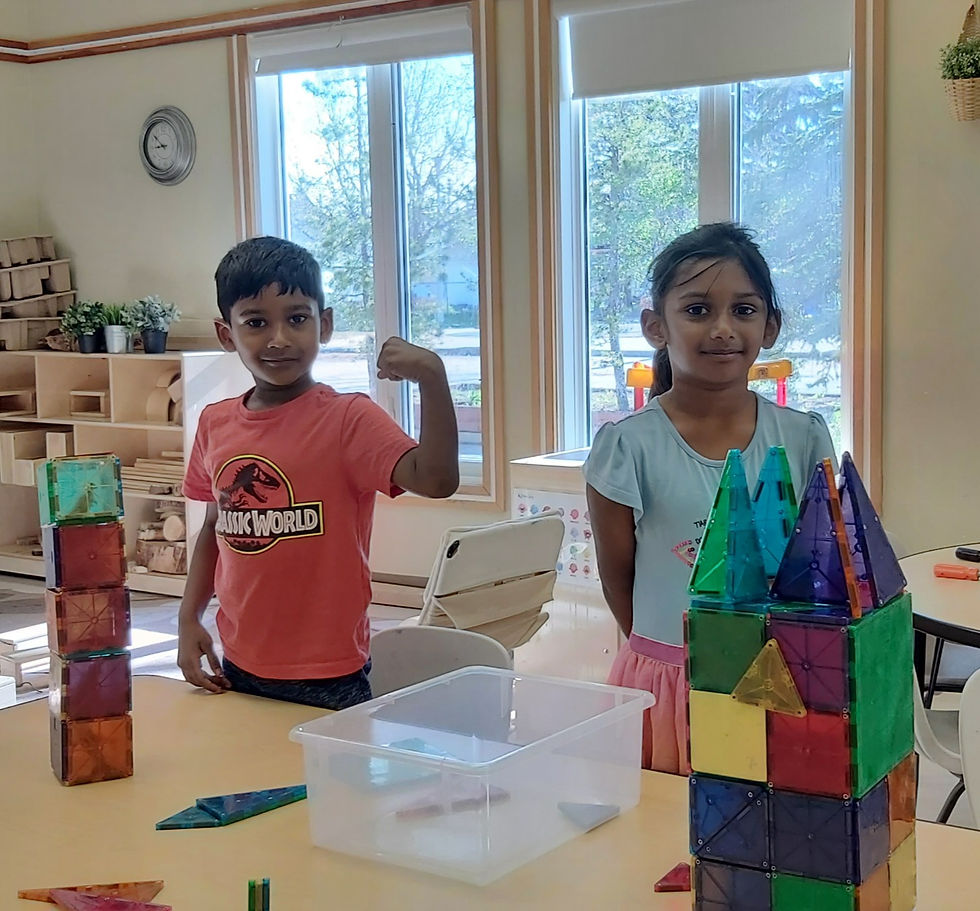The developmental domains: creative development
- norwoodcentre
- Aug 4, 2022
- 4 min read
Updated: Jan 9, 2025

Welcome to August and our exploration of creative development! Over the past few months, we have been exploring the developmental domains: social, physical, language, and intellectual development. This month we will examine the importance of the creative domain, what it is, how it develops, and how adults can promote creative development in children.
Creative development involves exploration, self-expression, decision-making, problem-solving, and applying knowledge. The beauty of creative development is that there is no right or wrong way for children to experience, take part in, grow, and explore their creativity!
Creativity opens us up to new and endless possibilities. In no other developmental domain are children as free to express themselves as when they are developing through creative outlets. When we think of creative opportunities, we tend to think of art centers and classes with plenty of crayons, markers, paper, scissors, and paint; but did you know creative development goes beyond the everyday arts and crafts table? We can express our creativity through things like colour, marks we make on paper, how we group items and fit shapes together, how we use our voices and choose words, how we move our bodies, think about complex ideas, and solve problems.

At Norwood Child and Family Resource Center, we strive to provide time, space, and materials to children to help build their potential within the creative domain. We do this because we recognize the many beneficial and positive impacts these opportunities have on children.

This month, our social media posts will focus on and support four main areas:
Social influences on creativity: how family, culture, and environment affect creative thinking and how children express themselves.
Creative self-expression: how children choose materials and how they use them to invent, imagine, create, test, and build theories.
Creativity and problem-solving: how creative thinking supports problem-solving, for example: finding out how things may or may not work and trying out new ideas and different ways of thinking.
Creativity and divergent thinking: children can engage all their senses through exploration and discovery by not focusing on one correct way to accomplish a goal (the value is in the journey, not the destination).
This child is using her creativity to solve a problem she's having with her blocks. She found two blocks of similar height, but one is too thin to balance and will not support her bridge. She used creative thinking to solve the problem by stacking smaller blocks to make a support of similar height.
Creativity can be encouraged just like any other skill. To create an environment that assists in developing creative thinking, keep in mind the following:
Time: allow ample time for children to explore, manipulate and come up with new ideas.
Give supportive and positive feedback: create a safe place for children to make mistakes and treat those mistakes as an opportunity to try something new.
Limit adult expectations: allow children to explore and manipulate in ways that excite THEM, create experiences that use time, space, and materials together, and limit restrictions and restraints to encourage creative expression and problem-solving.
Respect choice in creativity: some people like to paint while others would rather dance and still others like to use words. Some people prefer designing the building; some prefer building it - both are expressions of creativity.
Emphasize process over product: ask open-ended questions to show your interest and encourage children to think about what they are doing and why. For example, you might ask, “did you enjoy this? What was the most exciting part for you?”
Exploring and trying new things will not only broaden your child's experiences and build their creative abilities, but it will also benefit yours! Remember, everything that children create has worth and is valuable beyond measure.
For fun Creative Development activity ideas, check out our Child Development Activities page!
Norwood Child and Family Resource Centre has supported vulnerable children, youth and families in Edmonton for more than 60 years. We provide free programming that supports optimal child development, strengthens healthy relationships and well-being, breaks cycles of adversity, empowers people to successfully navigate change and life challenges, and connects people to communities. Norwood Centre is inclusive and respectful of diversity, recognizing that each family is unique. Our work is strength-based, trauma informed and responsive to the needs of our participants.
Our team of qualified Early Childhood Development Subject Matter Experts works to provide tools that caregivers can use to support early childhood development. We hear you! If you have a question or concern, please ask us. We have a variety of Child Development Activities available on our website, including the topics of Social Development, Physical Development, Language Development, Intellectual Development, Creative Development and Emotional Development. Find them at norwoodcentre.com/child-development-activities. For short-term one-on-one coaching, please call us at 780-471-3737.
.png)










Comments